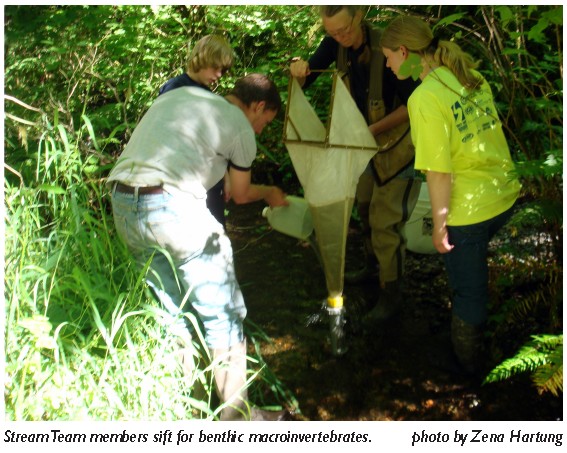Stream Team Works MacroinvertebratesBy Zena Hartung
The information provided to Stream Team volunteers is a dense packet along with the evening of hands-on training. The morphology, lifespan, and watery habitats are all discussed. It is a mini-biology class and provided more education than I was expecting. Macroinvertebrates encompasses a wide range from snails (Mollusca) to crayfish and flies (Arthropoda-animals with exoskeletons to wormlike creatures (Annelida). These bugs act as superior indicators of stream health. Scientists can test the water for dissolved oxygen, they can count fish passing through, but the resident population of bugs in a stream are the best indicators of what has occurred there. Macroinvertebrates must reside, submerged from four months to a year or more, and many are dependent on clean water to survive: they cannot swim away from a source of pollution. If benthic macroinvertebrates are found in sufficient quantity and diversity it can indicate good stream health. If the samples contain mostly macroinvertebrate populations that are tolerant of poor water quality, such as low dissolved oxygen, it can indicate poor water quality. Of course, the sampling has to be consistent in technique and volume, and the Stream Team has taken on that challenge. From five streams in 1998, today Stream Team monitors 20 major creeks in Thurston County, through a cooperative arrangement between Olympia, Lacey, Tumwater and Thurston County. The fundamentals of the program grew out of a monitoring protocol developed by Dr. James Carr, retired professor of biology from the University of Washington. He worked to develop a sampling for shallow (10-40 cm) lowland streams in Puget Sound. Today his protocol is used in other states and areas outside Puget Sound as well. Ann Marie Finan, an Outreach and Education Specialist for Thurston County's Resource Stewardship Department and one of the Coordinators for the regional Stream Team Program coordinates the monitoring program. First she educates the new volunteers, then informs all volunteers of the schedule for going to the creeks. Many volunteers have returned year after year. One outstanding volunteer is Mark Davis of Tumwater. He said, "I trained with Stream Team to do macro-monitoring in 2005 or 2006. It sounded fun and my mom got me started. She can't make it any more, but I've been doing it every summer since." Mark is 16 and in training to be a Counselor at the Natural Resources Youth Camp. He noticed recently that the monitoring has been turning up leaches. I asked him why that worried him. "Leaches are pollution tolerant and don't indicate healthy streams." He said his knowledge of what should and shouldn't be found in streams has made him very aware of littering and he makes sure that any cans or litter he finds while monitoring is collected and removed. Finan had two long range goals for the "macro-monitoring" program. She hopes to see the BIBI data integrated into the mass of information collected about stormwater, weather trends, precipitation and other data. "Macro monitoring is one important index of stream health. But if we can combine all we know today about our water quality and water quantity, we can use it to inform decisions on growth and development in the future." Hand in hand with that goal is her hope to help more people be "streamkeepers" and to help educate the next generation about the importance of healthy streams. To find out more about Stream Team's "macro-monitoring" program go to: http://www.streamteam.info Zena Hartung is a Thurston County Water Conservancy Commissioner and a board member of Carnegie Group and the Deschutes Estuary Restoration Team.
Back to Home page. |

 Last spring Stream Team began the annual appeal to the community, seeking volunteers who would be trained to go into local streams and help with collecting "benthic macroinvertebrates", better known as "stream bugs," found in stream beds. I signed up, believing that the opportunity would familiarize me with location and appearance of the smaller creeks in Thurston County. I went to the training in June held one evening at McLane Creek Nature trail. As suspected, there were some kids there: kids always love bugs, love getting wet and going into the woods. But there were more adults than children. We learned proper technique for collecting samples. Those samples, once all collecting is complete, will be sent to a lab in Corvallis, Oregon where Bob Wisseman of Aquatic Biology Associates also trains volunteers. His assistants count the benthic macroinvertebrates (bugs without spines "invertebrates" that are big enough to see "macro" and "benthic" are bottom dwellers) and categorize them. The characterization and volume results in a final score called the Benthic Index of Biological Integrity (BIBI). Thus each stream gets an annual rating of its health based on its bug population.
Last spring Stream Team began the annual appeal to the community, seeking volunteers who would be trained to go into local streams and help with collecting "benthic macroinvertebrates", better known as "stream bugs," found in stream beds. I signed up, believing that the opportunity would familiarize me with location and appearance of the smaller creeks in Thurston County. I went to the training in June held one evening at McLane Creek Nature trail. As suspected, there were some kids there: kids always love bugs, love getting wet and going into the woods. But there were more adults than children. We learned proper technique for collecting samples. Those samples, once all collecting is complete, will be sent to a lab in Corvallis, Oregon where Bob Wisseman of Aquatic Biology Associates also trains volunteers. His assistants count the benthic macroinvertebrates (bugs without spines "invertebrates" that are big enough to see "macro" and "benthic" are bottom dwellers) and categorize them. The characterization and volume results in a final score called the Benthic Index of Biological Integrity (BIBI). Thus each stream gets an annual rating of its health based on its bug population.